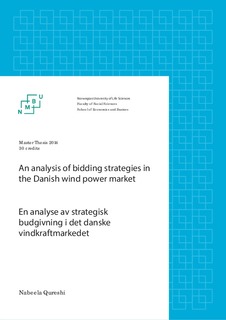| dc.contributor.author | Qureshi, Nabeela | |
| dc.date.accessioned | 2014-08-15T12:03:11Z | |
| dc.date.available | 2014-08-15T12:03:11Z | |
| dc.date.copyright | 2014 | |
| dc.date.issued | 2014-08-15 | |
| dc.identifier.uri | http://hdl.handle.net/11250/217351 | |
| dc.description.abstract | In 2013 the wind turbines in Denmark accounted for approximately 30 % of Denmark's total electricity supply (Jensen and Sørensen 2014). The 2020 goal necessitates wind supply increase from 30% to 50 % (Lentz and Strandmark 2014). The expansion of the wind power sector raises several questions regarding its strategic effect on the spot and the regulation market. The suspicion is that increased amount of wind power will trigger systematic use of the regulation market. The area of focus is West-Denmark and the problem for discussion is stated in this manner: How does deviation between predicted production and actual production of wind-power in West-Denmark affect the bidding in the spot market?
The interest is to use the regulation market and wind prognosis to find the deviations between the supply bids made to the spot market, and actual delivery. The bids made to Nord Pool are confidential. The analysis is done without this information. Two hypotheses are formulated in order to answer the problem of discussion, and two models are developed in order to test these hypotheses Model 1 and Model 2.
In Model 1 the effects of up and down regulation are tested on price for balancing regulation. The goal in this model is to reveal the relationship between up and down-regulation price to check for asymmetries in the regulation market. In Model 2 wind power production is tested, as an exogenous predictor of total regulation. The data used to test Model 1 and Model 2 is downloaded from energinet.dk, except the data on wind prognosis. The data on wind prognosis is downloaded from Nord Pool´s website. The data downloaded is from 01.01.2012 to 31.12.2013. The estimation strategy in Model 1 is the use of OLS, and the estimation strategy in Model 2 is based on regression analysis with possible measurement error, where wind prognosis is used as an instrumental variable. The findings in Model 1 suggest that there is difference in price for up-and down regulation, and that the use of the regulation market is slightly asymmetric.
The findings in Model 2 rejected the second hypothesis, and wind power production is an endogenous predictor of total regulation. The deviation between planned and actual production of wind power can be used as an incentive to place the supply bids strategically on the spot market, to obtain a better price in the regulation market. Significant measurement error in Model 2 can be regarded as indirect evidence of systematic action
I 2013 stod vindkraftsektoren for 30 % av den totale kraftproduksjonen i Danmark, ( Jensen og Sørensen 2014 ). Et mål for år 2020 er en økning fra 30% til 50% ( Lentz og Strandmark 2014 ). Den planlagte utvidelsen av vindkraftsektoren reiser flere spørsmål rund strategisk budgivningsadferd i spot og kraftreguleringsmarkedet. Det mistenkes at ved økt vindkraft i kraftsystemet vil det utløse systematisk bruk kraftreguleringsmarkedet. Denne analysen begrenser seg til Vest-Danmark og problemstillingen er formulert som følgende: Hvordan vil et avvik mellom planlagt og faktisk produksjon av vindkraft i Vest-Danmark påvirke budgivning i spotmarkedet?
Hovedmålet er å bruke reguleringskraftmarkedet og vindprognose for å finne avvik mellom bud i spot markedet og faktisk levert produksjon. Budgivningen i Nord Pool regnes som konfidensiell og problemstillingen besvares uten denne informasjonen. For å besvare problemstillingen er det i hovedsak formulert to hypoteser, og hypotesene ble testet basert på to modeller, modell 1 og modell 2.
I modell 1 blir effekten av opp -og nedregulering testet mot prisen i kraftreguleringsmarkedet. Målet er å klargjøre forholdet mellom opp –og nedreguleringsprisen for å gjennomskue potensielle asymmetrier i kraftreguleringsmarkedet. I modell 2 blir vindkraftproduksjon testet som en eksogen variabel til å predikere den totale reguleringen i kraftreguleringsmarkedet. Begge modellene er basert på data som er hentet fra energinet.dk, bortsett fra data for vindprognose, som er hetet fra hjemmesiden til Nord Pool. Dataen gjelder fra 01.01.2012 til 31.12.2013. OLS metoden ble brukt til å estimere modell 1. Estimerings strategien til modell 2 faller under 2SLS der vindprognosen ble brukt som en instrumentell variabel. Modell 2 ble testet for systematiske målefeil.
Hovedfunnene i modell 1 indikerer en prisforskjell mellom opp -og nedregulering. I tillegg er det hint av asymmetrier når det kommer til bruken av kraftreguleringsmarkedet. Funnene i modell 2 indikerer at vindkraftproduksjon er en endogen variabel i sammenheng med total regulering. Avviket mellom planlagt og virkelig produksjon av vindkraft kan brukes som et insentiv systematisk vis anlegge bud på spotmarkedet. Betydelig målefeil i Modell 2 kan anses som indirekte bevis på systematisk handling for å få en bedre pris i reguleringskraftmarkedet. | nb_NO |
| dc.language.iso | eng | nb_NO |
| dc.publisher | Norwegian University of Life Sciences, Ås | |
| dc.relation.haspart | bidding strategies, wind production, wind prognosis, Nord Pool,energy economics, regulation market, vindproduksjon, strategisk budgivning, vindprognose, kraftreguleringsmarkedet, | nb_NO |
| dc.subject | Energy economics | nb_NO |
| dc.subject | VDP::Samfunnsvitenskap: 200::Økonomi: 210 | nb_NO |
| dc.title | An analysis of bidding strategies in the Danish wind power market | nb_NO |
| dc.title.alternative | En analyse av strategisk budgivning i det danske vindkraftmarkedet | nb_NO |
| dc.type | Master thesis | nb_NO |
| dc.source.pagenumber | 65 | nb_NO |
| dc.description.localcode | M-ØA | nb_NO |
